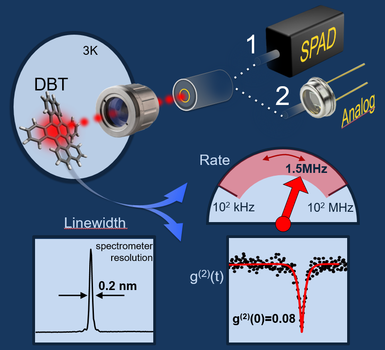Please type a search term (at least two characters)
News
Quantum EMPIR project features in prestigious publication

Paper about new single-photon source is published in Advanced Quantum Technologies
EMPIR project Single-photon sources as new quantum standards (17FUN06, SIQUST) is carrying out the fundamental work needed to develop a new quantum standard, assessing and establishing new materials and designs for single-photon sources. Light sources that can emit single photons are a building block of optical quantum technologies, which have far-reaching applications from low-flux radiometry and ultra-secure communication to biomedical imaging.
The work of the project was described in the paper ‘A Molecule-Based Single-Photon Source Applied in Quantum Radiometry’ published in the publication Advanced Quantum Technologies.
Background
Single-photon sources based on quantum emitters hold potential as standards in the complex field of quantum radiometry for photon fluxes at very low light levels. Ideally this requires control over the photon flux in a wide dynamic range, non-classical photon statistics, and a narrow-band emission spectrum.
In this EMPIR project, a monochromatic single-photon source based on an organic dye molecule was used. Its photon flux was absolutely measured, traceable to the standards for optical photon flux, and seen to be up to 1320 000 (single) photons per second at a wavelength of 785.6 ± 0.1 nm. This corresponds a very small optical radiant flux of just 334 fW.
Single-photon avalanche detectors are applicable only to small photon fluxes. Also, they can only detect one photon per time, even if more than one photon arrives. Lasers and lamps emit more than one photon per time, even if attenuated. Therefore, if the calibration is carried out with attenuated lasers or light, significant corrections must be carried out.
This single-photon stream produced by the source developed by this project is very pure, meaning that the probability of having more than one photon in a stream is very low. Such a source is nearly perfect for the calibration of single-photon avalanche detectors against a standardly calibrated low-noise analog photodiode, because corrections due to multiple photon arrival at the detector are omitted. Due to the narrow bandwidth of the source, corrections to the detector efficiency arising from the spectral power distribution are not necessary. This is a major advantage and means that the device developed in this project may finally realise a low-photon-flux standard source for quantum radiometry, enabling easy, reliable and precise detector calibrations also at low photon fluxes.
Stefan Kück from PTB and Project Coordinator said
‘The project has a strong scientific and metrological impact, manifested by a large number of high-level publications and conference contributions. The scientific results will be exploited for the growing market of quantum technology by a possible uptake of the technological developments and by providing traceability for companies working in the quantum technologies area. In addition, this project will remove one of the current major roadblocks for quantum technology, which is the lack of high-efficient single-photon sources.’
This EMPIR project is co-funded by the European Union's Horizon 2020 research and innovation programme and the EMPIR Participating States.
Want to hear more about EURAMET?
Sign up for EURAMET newsletters and other information
Carbon dioxide, released from man-made activities, is lowering the pH of the Earth’s oceans, and impacting the health of marine organisms worldwide more
Supporting automated and reconfigurable manufacturing systems more
Working with external project Cool White to test and suggest improvements on the locally available white paints more
The project FutureEnergy has provided new calibration services for ultra-high voltages and a good practice guide on Lightning Impulse dividers more
For many of the 5000 photonics companies in Europe a precise knowledge of a material’s optical properties is vital for industrial competitiveness more





